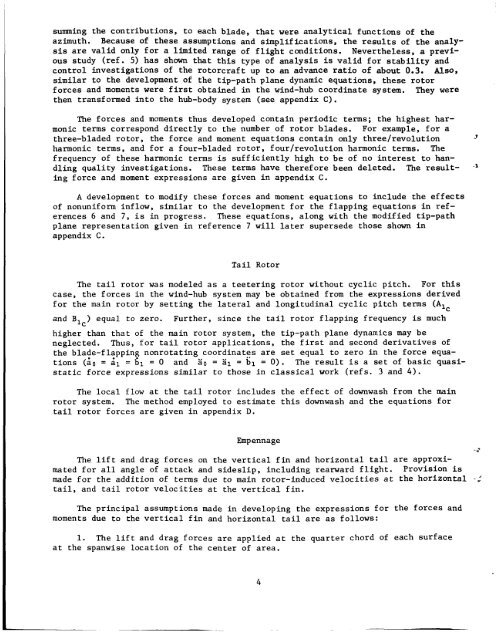A Mathematical Model of a Single Main Rotor Helicopter for ... - Read
A Mathematical Model of a Single Main Rotor Helicopter for ... - Read
A Mathematical Model of a Single Main Rotor Helicopter for ... - Read
Create successful ePaper yourself
Turn your PDF publications into a flip-book with our unique Google optimized e-Paper software.
summing the contributions, to each blade, that were analytical functions <strong>of</strong> the<br />
azimuth. Because <strong>of</strong> these assumptions and simplifications, the results <strong>of</strong> the analysis<br />
are valid only <strong>for</strong> a limited range <strong>of</strong> flight conditions. Nevertheless, a previous<br />
study (ref. 5) has shown that this type <strong>of</strong> analysis is valid <strong>for</strong> stability and<br />
control investigations <strong>of</strong> the rotorcraft up to an advance ratio <strong>of</strong> about 0.3. Also,<br />
similar to the development <strong>of</strong> the tip-path plane dynamic equations, these rotor<br />
<strong>for</strong>ces and moments were first obtained in the wind-hub coordinate system. They were<br />
then trans<strong>for</strong>med into the hub-body system (see appendix C).<br />
The <strong>for</strong>ces and moments thus developed contain periodic terms; the highest har-<br />
monic terms correspond directly to the number <strong>of</strong> rotor blades. For example, <strong>for</strong> a<br />
three-bladed rotor, the <strong>for</strong>ce and moment equations contain only three/revolution<br />
harmonic terms, and <strong>for</strong> a four-bladed rotor, four/revolution harmonic terms. The<br />
frequency <strong>of</strong> these harmonic terms is sufficiently high to be <strong>of</strong> no interest to han-<br />
dling quality investigations. These terms have there<strong>for</strong>e been deleted. The result- -'<br />
ing <strong>for</strong>ce and moment expressions are given in appendix C.<br />
A development to modify these <strong>for</strong>ces and moment equations to include the effects<br />
<strong>of</strong> nonuni<strong>for</strong>m inflow, similar to the development <strong>for</strong> the flapping equations in ref-<br />
erences 6 and 7, is in progress. These equations, along with the modified tip-path<br />
plane representation given in reference 7 w ill later supersede those shown in<br />
appendix C.<br />
Tail <strong>Rotor</strong><br />
The tail rotor was modeled as a teetering rotor without cyclic pitch. For this<br />
case, the <strong>for</strong>ces in the wind-hub system may be obtained from the expressions derived<br />
<strong>for</strong> the main rotor by setting the lateral and longitudinal cyclic pitch terms (Alc<br />
and Blc) equal to zero.<br />
Further, since the tail rotor flapping frequency is much<br />
higher than that <strong>of</strong> the main rotor system, the tip-path plane dynamics may be<br />
neglected. Thus, <strong>for</strong> tail rotor applications, the first and second derivatives <strong>of</strong><br />
the blade-flapping nonrotating coordinates .. are set equal to zero in the <strong>for</strong>ce equations<br />
(io = i1 = 61 = 0 and 20 = 81 = bl = 0). The result is a set <strong>of</strong> basic quasistatic<br />
<strong>for</strong>ce expressions similar to those in classical work (refs. 3 and 4).<br />
The local flow at the tail rotor includes the effect <strong>of</strong> downwash from the main<br />
rotor system. The method employed to estimate this downwash and the equations <strong>for</strong><br />
tail rotor <strong>for</strong>ces are given in appendix D.<br />
Empennage<br />
The lift and drag <strong>for</strong>ces on the vertical fin and horizontal tail are approximated<br />
<strong>for</strong> all angle <strong>of</strong> attack and sideslip, including rearward flight. Provision is<br />
made <strong>for</strong> the addition <strong>of</strong> terms due to main rotor-induced velocities at the horizontal -:<br />
tail, and tail rotor velocities at the vertical fin.<br />
The principal assumptions made in developing the expressions <strong>for</strong> the <strong>for</strong>ces and<br />
moments due to the vertical fin and horizontal tail are as follows:<br />
1. The lift and drag <strong>for</strong>ces are applied at the quarter chord <strong>of</strong> each surface<br />
at the spanwise location <strong>of</strong> the center <strong>of</strong> area.<br />
4<br />
3<br />
-3

















